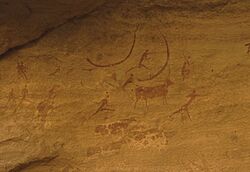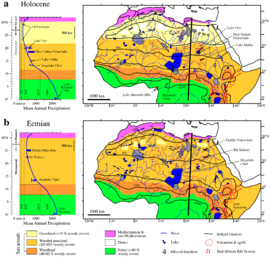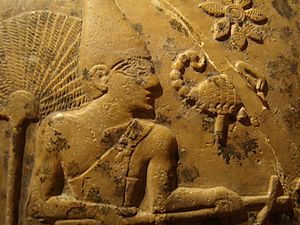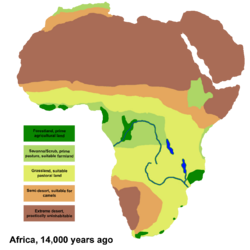Prehistoric North Africa facts for kids

The prehistory of North Africa is the story of humans in this region, from the very first people to the start of written history. This long period covers many thousands of years. The earliest modern humans lived in Morocco about 300,000 years ago. The Nile Valley, especially ancient Egypt, played a big role in the Neolithic (New Stone Age), Bronze Age, and Iron Age for the whole Old World.
Contents
North Africa's Changing Climate
Human life in North Africa has always been shaped by the climate of the Sahara desert. The Sahara is the world's largest hot desert, but it hasn't always been dry. Over hundreds of thousands of years, it has changed a lot between wet and dry periods.
These changes happen because of something called the Axial tilt cycle. Every 41,000 years, the Earth's tilt changes slightly. This affects how much sunlight different parts of the Earth get, which then changes the climate. Right now, the Sahara is dry, but scientists expect it to become green again in about 15,000 years.
During the last glacial period (Ice Age), the Sahara was much bigger than it is today. When the Ice Age ended, more rain fell in the Sahara from about 8000 BCE to 6000 BCE. This might have been due to low-pressure systems over the melting ice sheets. Once the ice sheets were gone, the northern Sahara started to dry out. In the southern Sahara, the monsoon rains kept it wet for a while, reaching further north than they do now. But by around 4200 BCE, the monsoon moved south, causing the Sahara to slowly turn into a desert. Today, the Sahara is as dry as it was about 13,000 years ago.
These climate changes led to what is called the Sahara pump theory. When the Sahara was wet and green, it was like a savanna grassland. Many different plants and animals lived there. But when dry periods came, the Sahara turned back into a desert. This forced animals and plants to move. They went north to the Atlas Mountains, south into West Africa, or east into the Nile Valley. This separation of groups in different climates made them adapt and sometimes even led to new species forming.
Early Stone Age: Paleolithic Period
The Paleolithic period is the earliest part of the Stone Age.
Lower Paleolithic: First Humans
The very first humans in central North Africa left important clues behind. Some of the oldest human tools were found in Ain el Hanech, Setif, dating back between 2 million and 1.47 million years ago. These tools show a very early type of technology called Oldowan.
Middle Paleolithic: Modern Humans Appear

Scientists have found bones of early anatomically modern humans at a place called Jebel Irhoud in Morocco. These remains are about 300,000 years old! This shows that our direct ancestors lived in North Africa a very long time ago.
In Egypt, near Nazlet Sabaha, people started digging for chert (a type of rock) about 100,000 years ago. They likely used this rock to make tools.
In the Sahara, a group of people called Aterians lived near lakes, rivers, and springs. They were skilled hunters, catching animals like antelope, buffalo, elephants, and rhinoceroses. They also gathered plants for food. When the Sahara became very dry, around the time of Europe's Ice Age, these Aterian hunter-gatherers might have moved to wetter areas like tropical Africa or the coastal areas. Some may have moved south into West Africa.
An amazing archaeological site called Affad 23 in Sudan shows well-preserved remains of ancient camps. It even has relics of the oldest open-air hut in the world, dating back about 50,000 years. This site also shows places where people hunted and gathered food.
Upper Paleolithic: New Cultures
The Iberomaurusian culture appeared around 25,000 to 23,000 years ago, during the peak of the last Ice Age. This culture lasted until about 11,000 years ago.
Archaeological findings show that people lived in Nubia (part of modern-day Sudan) as early as the Late Pleistocene. However, there is less evidence of human presence in the Egyptian Nile Valley during these times, possibly because sites there were not as well preserved.
Middle Stone Age: Mesolithic Period
The Capsian culture was a very important culture in the Maghreb (Northwest Africa) that existed from 8000 BCE to 2700 BCE. It covered both the Mesolithic and early Neolithic periods.
The Central Saharan rock art tells us a lot about these times.
- The Bubaline Period rock art, which includes engraved images, was made between 10,000 and 7500 years ago.
- The Kel Essuf Period rock art was created even earlier, before 9800 years ago.
- The Round Head Period rock art, which includes painted images, was made between 9800 and 7500 years ago.
Studies of ancient mummies, like the Uan Muhuggiag child mummy, suggest that the people living in the Central Sahara during these periods had dark skin.
New Stone Age: Neolithic Period

The Neolithic period saw big changes, especially the start of farming and raising animals.
Farmers from Northeast Africa and the Near East might have been the first to develop the ability to digest milk as adults (called lactase persistence). This trait then spread to other groups. For example, the Fulani people in Sub-Saharan West Africa, the Tuareg in North Africa, and early European farmers all share a specific gene for lactase persistence. This gene likely spread with cattle herding. There is evidence of people milking animals in the Central Sahara by at least 7500 years ago.
The engraved and painted Central Saharan rock art from the Pastoral Period was created between 7500 and 2800 years ago. These artworks often show scenes of herding animals. One of the earliest Libyco-Berber writings in Africa is found near a rock carving of an animal, possibly linked to a pastoral community.

In 2000, archaeologists found human remains at a site called Gobero in the Ténéré Desert of Niger. These finds are incredibly well-preserved and show two distinct cultures: the Kiffian (7700 BCE – 6200 BCE) and the Tenerian (5200 BCE – 2500 BCE).
During World War II, a British archaeologist named Anthony Arkell studied a Late Stone Age settlement on a sandbank of the Blue Nile in Sudan. He found bones of antelopes, showing that the area was a savanna, not a desert, back then. The people likely ate a lot of fish. Arkell concluded that rainfall was at least three times higher than today. The bones suggested these people were related to modern Nilotic groups like the Nuer and Dinka. Radiocarbon dating showed the site was from 7000 BCE to 5000 BCE. Arkell also found similar tools and a special type of "wavy line pottery" at other sites across Africa, suggesting a common fishing and hunting culture. These people were black African and seemed to be growing grain crops, not just gathering wild ones.
Many experts believe that the ancient Egyptian civilization started from pastoral (herding) communities in the Egyptian and Sudanese parts of the Nile Valley around 5000 BCE.
Historian Christopher Ehret notes that studies of ancient Egyptian burial sites, like El-Badari and Naqada, show that the people there were closely related to other long-term populations in Northeast Africa, such as Nubia and the northern Horn of Africa. He suggests these populations were not new arrivals but descendants of people who had lived in these parts of Africa for thousands of years.
Fishing cultures with "dotted wavy line pottery" have also been found near Lake Turkana. By 3000 BCE, while fishing was still important, the specific pottery and harpoon users were no longer present in the Turkana Basin.
Later Central Saharan rock art includes:
- The Caballine Period rock art, with engraved images, created between 2800 and 1000 years ago.
- The Cameline Period rock art, with both engraved and painted images, created from 2000 years ago onwards.
Neolithic in the Maghreb
Around 5000 BCE, the people of North Africa were mainly descendants of the Iberomaurusian and Capsian cultures. Later, new groups arrived with the Neolithic Revolution, bringing farming. The early Berber tribes developed from these ancient communities during the late Bronze and early Iron Ages.
Studies of people from Kehf el Baroud in the late Neolithic period suggest they had about 50% local North African ancestry and 50% ancestry from early European farmers. It's thought that this European ancestry came to North Africa through colonists from Spain who made "Cardial Ware" pottery, sometime between 5000 and 3000 BCE. These people were also closely related to the Guanches of the Canary Islands.
Bronze Age
The Bronze Age is when people started using bronze (a mix of copper and tin) to make tools and weapons.
Bronze Age in Egypt

In Ancient Egypt, the Bronze Age began around 3150 BCE, during the Protodynastic Period of Egypt. The "Early Bronze Age of Egypt," also known as the Early Dynastic Period of Egypt, started after Upper and Lower Egypt were united around 3100 BCE. This period includes the First and Second Dynasties and lasted until about 2686 BCE.
When the First Dynasty began, the capital moved from Abydos to Memphis. Egypt was now a united country ruled by a god-king. Abydos remained an important holy city in the south. Many famous parts of ancient Egyptian civilization, like their art, buildings, and religious beliefs, took shape during this Early Dynastic Period. Memphis was the largest city of its time.
The Old Kingdom is the name for a period in the 3rd millennium BCE when Egypt reached its first great peak of civilization. This was the first of three "Kingdom" periods, which mark the high points of civilization along the Nile River.
Bronze Age in the Maghreb
The Maghreb region moved from the Mesolithic to the Neolithic period between 6000 BCE and 5000 BCE. Then, it entered a period that was a mix of Neolithic, Chalcolithic (Copper Age), and Bronze Age, probably in the 2nd millennium BCE. However, the Maghreb never fully entered a true Chalcolithic or Bronze Age, staying in a transitional stage between the Neolithic and these later ages.
Iron Age
The Iron Age is when people learned to use iron, which is much stronger than bronze.
Iron Age in Egypt
The Iron Age in Egypt matches up with the Third Intermediate Period of Egypt. Interestingly, iron objects are quite rare in ancient Egyptian collections. Bronze remained the main metal until the Neo-Assyrian Empire conquered Egypt in 671 BCE. This might be because many ancient Egyptian objects come from tombs, and iron was seen as an "impure" metal. It was linked to Seth, the god of evil, so it wasn't used for religious items or funeral objects.
However, some iron pieces have been found, like those in the Black Pyramid of Abusir (before 2000 BCE). Iron is also mentioned in ancient texts. A sword with the name of Pharaoh Merneptah and an axe with an iron blade were found in Ugarit. A famous dagger with an iron blade found in Tutankhamun's tomb (13th century BCE) was recently studied and found to be made from a meteorite!
Iron Age in the Maghreb
The Phoenician colonization along the coast, who were skilled in iron-working, and their trade with inland areas helped the Maghreb quickly move from its mixed metal age into the Iron Age.
See also



